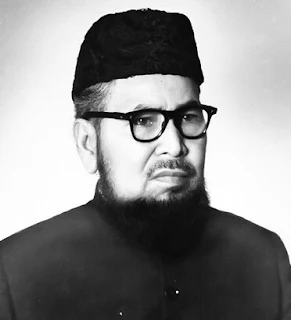Maulvi Tamizuddin, and Case Vs Federal Government
 |
| Maulvi Tamizuddin |
Maulvi Tamizuddin (1889–1963) was a Bengali politician, lawyer, orator, and speaker of the first constituent assembly from 1948 to 1954 . He was the man who was initially wholly in favour of Hindu-Muslim unity but later filled with a sense of Muslim freedom. His political and intellectual ingenuity stood out during the Maulvi Tamizuddin Case, when Governor-General Malik Ghulam Muhammad dissolved the Constituent Assembly on April 24, 1954. Thus, Maulvi Tamizuddin bravely challenged the decision of dissolution. He fought for democratic norms in the country. The unwavering services of Maulvi Tamizuddin for the country earned him the title of "flag bearer of democratic values."
Maulvi Tamizuddin (1889–1963) was born in Faridpur, Dhaka. He had remained the speaker of the first constituent assembly of Pakistan and a member of the National Assembly of Pakistan. Speaking of his educational and professional career, he got his early education from his home town, then went to Scottish Churches College and Presidency College Calcutta. Once completing an M.A. from Presidency College and, then, law from Rippon College, he decided to step into politics. It was the time when the anti-Bengal Partition Movement by the Congress was at its peak.
At first, Maulvi Tamizuddin favoured Hindu-Muslim unity. Thus, he joined the Indian National Congress in 1921. However, when he saw that Hindus strongly opposed the division of Bengal, Maulvi Tamizuddin, greatly inspired by the speeches of Ambika Charan, the president of Congress, used these skills against the partition of Bengal in 1905. He knew that Muslim freedom was greatly associated with the partition of Bengal.
Maulvi Tamizuddin had been to jails in Faridpur and the central jail in Dhaka in 1923 due to his political activities. When he was secretary of the Congress party, he fought elections against Farid Pur for the municipal seat, but Hindus elected a Hindu leader against him. Due to this bias of Hindus against the Muslim community, Maulvi Tamizuddin left the Congress in 1926.
Maulvi Tamizuddin was very anxious about the Shuddhi Movement, which had been launched to convert Muslims to Hinduism. Moreover, he took part in the 1937 elections on the Muslim League ticket and defeated the Congress candidate, Hamayun Kabir. Maulvi Tamizuddin was granted the title of "Khan Bahadur" by the British, which he refused to accept.
Maulvi Tamizuddin Case:
To give a newly established country a constitution, the Constituent Assembly was formed under the Government of India Act, 1935 which was given by the colonial British.The responsibility and functions of the Assembly were to make a constitution for the newly independent country. The Constituent Assembly is comprised of 76 members and a president. Quaid-e-Azam Muhammad Ali Jinnah became the president of the Constituent Assembly of Pakistan on August 11, 1947, while Maulvi Tamizuddin Khan as its deputy president.
Shortly after Quaid-e-Azam's death in 1948, Maulvi Tamizuddin became the President of the Constituent Assembly. Since the Governor-General had the power to dissolve any minister under the Government of India Act, 1935, Ghulam Muhammad dissolved the Constituent Assembly on April 24, 1954, saying that the assembly had lost the confidence of the people. Exercizing the same powers, Ghulam Muhammad had dismissed the previous Prime Minister, Khawaja Nazimuddin, in March 1953 and assigned the office of PM to Muhammad Ali Bogra.
Maulvi Tameezuddin challenged the unconstitutional act of Governor General Ghulam Muhammad in the Sind High Court on November 7, 1954, through Advocate Manzar-e-Alam. He was of the opinion that the Governor General's proclamation was unconstitutional and illegal. As, according to Tamizuddin, Pakistan is an independent and free country, it could not be run under the law of slavery. The Chief Court of Sindh decided unanimously in favour of Maulvi Tamizuddin and restored the assembly. It was a temporary success for the democratic process in the country.
The government, however, filed an appeal against the decision of the Sindh Court in the Federal Court, now the Supreme Court. The Chief Justice of the Federal Court, Muhammad Munir, gave a decision in favour of the government. In addition, the decision of the Sindh Court was entirely dismissed by the federal court on March 21, 1955, by invoking the highly controversial "doctrine of necessity." Moreover, the judges who justified Governor Gensler's move were Justice Muneer, Justice Muhammad Shareef, Justice Muhammad Akram, and Justice S.A. Rahman. And the only judge who contracted them all was Justice Allen Robert Cornelius. He wrote in contradiction that Pakistan is an independent and free country, and thus its assembly cannot be dismissed under the Government of India Act 1935, which was given by the British colonials.
The decision of the federal court was a landmark in the subsequent political and judicial history of Pakistan. It opened doors for dictators in the fragile democracy of Pakistan. Similarly, the second constituent assembly was also dissolved, and the third constituent assembly of Pakistan in any way gave a constitution. The decision led to the "law of necessity" that was used many times to derail democracy in Pakistan. However, the decision caused irreparable loss to the democratic process in the country.
Maulvi Tamizuddin, in order to restore democratic processes in the country, faced a lot of resistance in filling the case. His house was under police custody. Thus, it was hard for him to reach the Sindh court. So, under a veil and from the back of his house, he went to the chief justice of the Sindh high court.
Because of his constitutional fight, he is known as the flag bearer of democratic norms.


~2.png)
Comments
Post a Comment